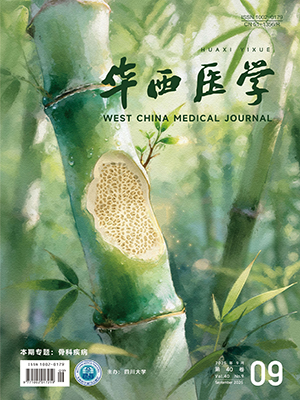【摘要】 目的 研究双侧迷走神经切断对肺缺血再灌注引起的氧化应激反应的影响。 方法 将24只健康雄性新西兰大白兔随机分为:假手术组(S组)、缺血再灌注组(IR组)、双侧迷走神经切断合并缺血再灌注组(NIR组)。缺血前和再灌注末抽取动脉血进行血气分析,观察动脉血氧分压PaO2及肺泡动脉氧分压差(A-aDO2)的变化。再灌注末取肺组织检测肺的湿干重比值(W/D)和氧化应激指标,包括丙二醛(MDA)、超氧化物歧化酶(SOD)及过氧化氢酶(CAT)。 结果 与S组比较,缺血再灌注明显降低了PaO2,增加了A-aDO2和W/D值,增加了肺组织MDA含量并降低了SOD、CAT活性;双侧迷走神经切断进一步降低了SOD活性。 结论 切断实验兔的双侧迷走神经,降低了肺组织抗氧化酶-超氧化物歧化酶的活性,提示迷走神经在降低肺缺血再灌注引起的氧化应激反应中发挥了重要的调节作用。
【Abstract】 Objective To evaluate the effect of bilateral vagal nerves transection on lung ischemia-reperfusion induced oxidative stress. Methods A total of 24 New Zealand male rabbits were randomly divided into 3 groups: sham group (S group), ischemia-reperfusion group (IR group), and bilateral vagal nerves transection with ischemia-reperfusion group (NIR group). Before ischemia and at the end of reperfusion, arterial blood samples were collected for blood gas analysis. Arterial partial pressure of oxygen (PaO2) and alveolo-arterial oxygen tension difference (A-aDO2) were detected. At the end of reperfusion, lung tissues were obtained to measure wet/dry weight ratio (W/D). Evaluation of oxidative stress indicators, including content of lung malondialdehyde (MDA), superoxide dismutase enzyme (SOD) and catalase (CAT) activities was also performed. Results Compared with the S group, lung ischemia-reperfusion significantly decreased the PaO2, elevated A-aDO2 and lung W/D weight ratio. At the same time, MDA level in the lung tissue was elevated and SOD and CAT activities were decreased. After bilateral vagal nerves transection, SOD activity was further decreased. Conclusion Transection of bilateral vagal nerves reduced the activity of antioxidant enzyme, especially superoxide dismutase in lung tissue, suggesting that the integrity of the vagal nerves plays an important regulatory role in ischemia-reperfusion mediated oxidative stress in the lung.
Citation: JIANG Rui,JI Peng,JIANG Tao,WANG Rurong. The Effect of Bilateral Vagal Nerves Transection on Lung Ischemia-reperfusion Induced Oxidative Stress. West China Medical Journal, 2011, 26(3): 325-327. doi: Copy
Copyright © the editorial department of West China Medical Journal of West China Medical Publisher. All rights reserved




